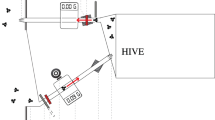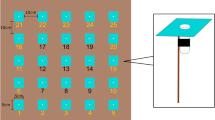Abstract
Forager honey bees function not only as gatherers of food for their colonies, but also as sensory units shaped by natural selection to gather information regarding the location and profitability of forage sites. They transmit this information to colony members by means of waggle dances. To investigate the way bees transduce the stimulus of nectar-source profitability into the response of number of waggle runs, I performed experiments in which bees were stimulated with a sucrose solution feeder of known profitability and their dance responses were videorecorded. The results suggest that several attributes of this transduction process are adaptations to enhance a bee's effectiveness in reporting on a forage site. (1) Bees register the profitability of a nectar source not by sensing the energy gain per foraging trip or the rate of energy gain per trip, but evidently by sensing the energetic efficiency of their foraging. Perhaps this criterion of nectar-source profitability has been favored by natural selection because the foraging gains of honey bees are typically limited by energy expenditure rather than time availability. (2) There is a linear relationship between the stimulus of energetic efficiency of foraging and the response of number of waggle runs per dance. Such a simple stimulus-response function appears adequate because the range of suprathreshold stimuli (max/min ratio of about 10) is far smaller than the range of responses (max/min ratio of about 100). Although all bees show a linear stimulus-response function, there are large differences among individuals in both the response threshold and the slope of the stimulus-response function. This variation gives the colony a broader dynamic range in responding to food sources than if all bees had identical thresholds of dance response. (3) There is little or no adaptation in the dance response to a strong stimulus (tonic response). Thus each dancing bee reports on the current level of profitability of her forage site rather than the changes in its profitability. This seems appropriate since presumably it is the current profitability of a forage site, not the change in its profitability, which determines a site's attractiveness to other bees. (4) The level of forage-site quality that is the threshold for dancing is tuned by the bees in relation to forage availability. Bees operate with a lower dance threshold when forage is sparse than when it is abundant. Thus a colony utilizes input about a wide range of forage sites when food is scarce, but filters out input about low-reward sites when food is plentiful. (5) A dancing bee does not present her information in one spot within the hive but instead distributes it over much of the dance floor. Consequently, the dances for different forage sites are mixed together on the dance floor. This helps each bee following the dances to take a random sample of the dance information, which is appropriate for the foraging strategy of a honey bee colony since it is evidently designed to allocate foragers among forage sites in proportion to their profitability.
Similar content being viewed by others
References
Bartholdi JJ, Seeley TD, Tovey CA, Vande Vate JH (1993) The pattern and effectiveness of forager allocation among flower patches by honey bee colonies. J Theor Biol 160:23–40
Boch R (1956) Die Tänze der Bienen bei nahen und fernen Trachtquellen. Z Vergl Physiol 38:136–167
Crozier RH, Page RE (1985) On being the right size: male contributions and multiple mating in social Hymenoptera. Behav Ecol Sociobiol 18:105–115
Drent RH, Daan S (1980) The prudent parent: energetic adjustment in avian breeding. Ardea 68:225–252
Eckert C (1990) The relationship between colony state and foraging strategy in the honey bee, Apis mellifera L. MSc. thesis, Simon Fraser University, British Columbia
Fewell JH, Ydenberg RC, Winston ML (1991) Individual foraging effort as a function of colony population in the honey bee, Apis mellifera L. Anim Behav 42:153–155
Fretwell SD, Lucas HL Jr (1970) On territorial behavior and other factors influencing habitat distribution in birds. Acta Biotheor 19:16–36
Frisch K von (1967) The dance language and orientation of bees. Harvard University Press, Cambridge
Gould JL (1976) The dance-language controversy. Q Rev Biol 51:211–244
Houston A, Schmid-Hempel P, Kacelnik A (1988) Foraging strategy, worker mortality, and the growth of the colony in social insects. Am Nat 131:107–114
Kacelnik A, Houston AI, Schmid-Hempel P (1986) Central-place foraging in honey bees: the effect of travel time and nectar flow on crop filling. Behav Ecol Sociobiol 19:19–24
Kleiber M (1961) The fire of life: an introduction to animal energetics. Wiley, New York
Laughlin SB, Hardie RC (1978) Common strategies for light adaptation in the peripheral visual systems of fly and dragonfly. J Comp Physiol 128:319–340
Lindauer M (1948) Über die Einwirkung von Duft- und Geschmacksstoffen sowie anderer Faktoren auf die Tänze der Bienen. Z Vergl Physiol 31:348–412
Lindauer M (1952) Ein Beitrag zur Frage der Arbeitsteilung im Bienenstaat. Z Vergl Physiol 34:299–345
Lumsden CJ, Hölldobler B (1983) Ritualized combat and intercolony communication in ants. J Theor Biol 100:81–98
Mellon D (1968) The physiology of sensory organs. Freeman, San Francisco
Michelsen A, Andersen BB, Storm J, Kirchner WH, Lindauer M (1992) How honeybees perceive communication dances, studied by means of a mechanical model. Behav Ecol Sociobiol 30:143–150
Neukirch A (1982) Dependence of life span of the honeybee (Apis mellifera) upon flight performance and energy consumption. J Comp Physiol 146:35–40
Page RE Jr, Robinson GE (1991) The genetics of division of labour in honey bee colonies. Adv Insect Physiol 23:118–168
Raveret Richter M, Waddington KD (1993) Past foraging experience influences honey bee dance behaviour. Anim Behav 46:123–128
Rothe U, Nachtigall W (1989) Flight of the honeybee. IV. Respiratory quotients and metabolic rates during sitting, walking and flying. J Comp Physiol B 158:739–749
Schmid-Hempel P (1987) Efficient nectar-collecting by honeybees. I. Economic models. J Anim Ecol 56:209–218
Schmid-Hempel P (1991) The ergonomics of worker behavior in social Hymenoptera. Adv Stud Behav 20:87–134
Schmid-Hempel P, Kacelnik A, Houston AI (1985) Honeybees maximize efficiency by not filling their crop. Behav Ecol Sociobiol 17:61–66
Schmid-Hempel P, Winston ML, Ydenberg RC (1993) Foraging of individual workers in relation to colony state in the social Hymenoptera. Can Entomol 125:129–160
Seeley TD (1983) Division of labor between scouts and recruits in honeybee foraging. Behav Ecol Sociobiol 12:253–259
Seeley TD (1986) Social foraging by honeybees: how colonies allocate foragers among patches of flowers. Behav Ecol Sociobiol 19:343–354
Seeley TD, Towne WF (1992) Tactics of dance choice in honey bees: do foragers compare dances? Behav Ecol Sociobiol 30:59–69
Shepherd GM (1988) Neuroscience, 2nd edn. Oxford University Press, New York
Sokal RR, Rohlf FJ (1981) Biometry, 2nd edn. Freeman, San Francisco
Somjen G (1972) Sensory coding in the mammalian nervous system. Appleton-Century-Crofts, New York
Stephens DW, Krebs JR (1986) Foraging theory. Princeton University Press, Princeton
Waddington KD (1985) Cost-intake information used in foraging. J Insect Physiol 31:891–897
Wilson EO (1971) The insect societies. Harvard University Press, Cambridge
Wolf TJ, Schmid-Hempel P (1989) Extra loads and foraging life span in honeybee workers. J Anim Ecol 58:943–954
Wolf TJ, Schmid-Hempel P (1990) On the integration of individual foraging strategies with colony ergonomics in social insects: nectar-collection in honeybees. Behav Ecol Sociobiol 27:103–111
Wolf TJ, Schmid-Hempel P, Ellington CP, Stevenson RD (1989) Physiological correlates of foraging efforts in honey-bees: oxygen consumption and nectar load. Functional Ecol 3:417–424
Young D (1989) Nerve cells and animal behaviour. Cambridge University Press, Cambridge
Author information
Authors and Affiliations
Rights and permissions
About this article
Cite this article
Seeley, T.D. Honey bee foragers as sensory units of their colonies. Behav Ecol Sociobiol 34, 51–62 (1994). https://doi.org/10.1007/BF00175458
Received:
Accepted:
Issue Date:
DOI: https://doi.org/10.1007/BF00175458




